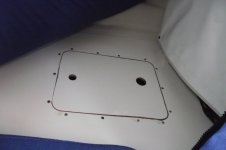colbysmith
Active member
- Joined
- Oct 2, 2011
- Messages
- 5,038
- Reaction score
- 15
- C Dory Year
- 2009
- C Dory Model
- 25 Cruiser
- Hull Identification Number
- UWH25301J809
- Vessel Name
- C-Traveler
To be clear, it's not a lot of flexing. But there does not appear to be any core in this area, and it sounds like other boats also have the core stop a few inches in front of the cabin bulkhead. I have no idea how thick that fiberglass is in the bow. I do know that this area takes a lot of beating in waves though. The foam I removed is "hard". That is, it would add additional support or strength to the bow in the area it reaches. While the foam did not fill the entire void, where it did fill would be a solid backing inside the hull that I would think would add overall "structure" to what appears to be fiberglass and gelcoat only. The flex is not a lot. But I can push hard with my hand and see the hull move if ever so slightly. Where I'm pushing is between the sides where the berth bunk material mates, and the keel. This is not aluminum. Hit hard enough by a pounding wave, I would think the fiberglass could be cracked. Then again, I'm not a boat builder or structural engineer. Right now I'm just very leary about how much support was removed from that area with the removal of the foam. A lot of speculation and opinion has been given in these forums. I just don't know what the qualifications of the writers are. What I would like to know, is has the actual boat builder been asked or given answers regarding this area and the removal of foam. If the newer boats that are coming with the storage compartments and hatches already installed are built in the exact same way, without additional strengthening or core in this area, then that would certainly encourage continuing to fabricate the older boats in this way. I just want to know that when I'm offshore in the Great Lakes with the pounding chop that I can trust my boat to take a good wave smack and not crack. This probably has a lot to do with my lack of much experience with this boat so far, and not being a structural engineer. Colby

